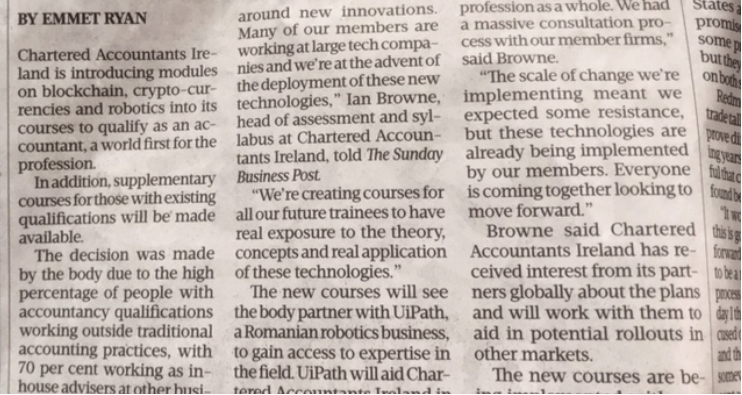Why you need to ‘sell’ RPA and Intelligent Automation to your business, and how to keep the right kind of attention needed to succeed – Part 1 of 4.
Everyday, leaders in organisations are faced with multiple decisions as to where to invest their time and money. Intelligent Automation, Robotic Process Automation, Digital and Analytics are exceptional tools. These tools can help most organisations digitally transform their businesses into Agile, digital dexterous organisations. But that means nothing to many business leaders who are faced with a 1000 different decisions a day and know nothing about the technology or what it can deliver.
“If you don’t act now, you will be like Thomas Cook. You will be like the old business dust of history. We can help and support as much as you want, yet the likes of innovation means you have to fail at times, and large businesses don’t like or reward failure. RPA will fail and accept it to fail. But recover fast, dust your self off stand up and fight again.
Directors/Heads of, are all concerned about cost and lack of failure. Suck it up and accept responsibly for technical innovation. Alexa failed 18 times before it was sold to the open market and its still failing. But over 100million were sold by 2019″
Graham Lee , Automation Jedi, Guru and all round good guy
Technology and digital transformation does not sell itself.
Executives don’t simply embrace automation, data analytics and digitisation without valid reasons. Therefore, it is incumbent on you to sell these technologies to your organisation at every opportunity.
To get the opportunity to implement and grow Robotic Process Automation and Intelligent Automation across an organisation, a clearly defined communications plan must be put in place. That plan must include key stakeholders and clear messaging about the many benefits of automation and how it helps deliver the business strategy.
“Organizations are quick to react to automation savings, adding fuel to the fire – when they know that those programs are underway. One of the biggest challenges to a successful intelligent automation program is continued, trusted key stakeholder buy-in. New technologies require “shouting from the rooftops” via Steering/Budget Committee scorecards and employee participation. The technology is proven, but similarly to riding a bike for the first time, it helps to hear it from others that you should give it a run.”
Adam Cranmer, CPA, PMP, Intelligent Automation Senior Manager
This article identifies some of the ways you can rise above the competition and noise that exist within every organisation, and sell the many benefits of Intelligent Automation, Robotic Process Automation, Digital and Analytics .
Automation delivers a range of business benefits.
Automation usually delivers a range of benefits. For example, by redesigning a process and making it more efficient with bots, benefits such as improved process compliance, reduced errors and omissions, improve employee experience etc. all naturally occur too. Therefore, it is incumbent upon you to tell the wider balance score card of the wins generated from your automation program as early and as often as possible.
“Demonstrate your ‘quick wins’ early on. This will enhance your relationship with the Executive Sponsor and Champions, and help to accelerate your automation program. From here, you would have demonstrated trust and credibility to scale your program. The CFO will be pleased as well!”
Janine Gill, Intelligent Automation Client Director

Figure 1: Example Balance Score Card of Automation Benefits
“Within any RPA team, or even any project, you are beholden to your stakeholders and leadership. Something I recommended (to ensure teams stay on the same page) that everyone has their Alignment, Clarity, and Transparency (ACT) together! Make sure that your team’s targets, goals and vision are Aligned so that they can be Clearly understood and Transparent to the stakeholders. Then make sure your team continually evidences the value you bring to the organization against those goals and targets.”
Doug Shannon, RPA Product Lead
Before you begin understand who your key stakeholders are and why might they want or need automation?
To get people to change, organisations must introduce a concept and a ‘why’ i.e. why change is necessary. Whilst we are in a period of Digital Darwinism, the message should not be negative.
Understand who your key stakeholders are. It is key to both understand; the stakeholders who will have the most influence on your #RPA project (e.g. executive sponsor and executive team; board; CISO, ICT, risk and compliance teams; etc.) and, the stakeholders who will be most affected by your project (e.g. internal staff impacted positively or negatively by RPA such as finance, HR, supply chain, call centre management staff, etc.).
- By completing a stakeholder matrix or mapping exercise you will see:
- Who has a financial stake/interest in your project.
- Who has an emotional interest (Don’t underestimate this. If this project was someone’s “baby,” keeping them happy and in the loop is critical).
- What are the top motivations for each stakeholder.
- Who are the biggest supporters.
- Who might be the biggest non-supporters or naysayers e.g. technophobes or business units who may lose their jobs and therefore, status due to your intelligent automation program.
- And how best you might target and influence the various groups you have identified.
“In today’s competitive market, increasingly knowledgeable customers with vast amounts of information at their fingertips have shifted their focus to businesses more in tune with individualised needs, as opposed to price point. This dynamic has led to a paramount of changes, including how organisations measure success. With many Intelligent Automation solutions, measuring customer satisfaction has become increasingly important, specifically the Net Promoter Score (NPS) which measures how likely customers are to recommend a business.
Organisations can use a three step approach to measure NPS:
1) Prior to Implementation – ‘The Temperature Check’
– A ‘temperature check’ is taken that serves as the initial benchmark to assess the customer perception of the existing solution (e.g. 7/10). Followed by an adjustment to incorporate resistance to change.
2) Implementation – ‘The Disruption’
– Disruption may result in customers feeling challenged or apprehensive. Therefore, a forecasted decrease would be expected for a predetermined latency period (e.g. -1 for 90 days).
3) Post Implementation – ‘The Result’
– When customers are familiar with the change, a secondary ‘temperature check’ is completed to assess client satisfaction. A positive outcome is measured as a score greater than the initial benchmark on a continuous basis (e.g. after 1 year, 2 years).
Note: It is important to control for other implementations, variables or changes in client behaviour during this time to ensure an accurate measurement of success.”
Lewis Walker, Intelligent Automation Architect
Never underestimate how key employee engagement is, to the success of your automation program. Have conversations with everyone in the organisation so you can understand how everyone maybe impacted, Remember to follow the principle of two ears and one mouth when listening to their hopes, worries and fears i.e. spend twice as much time listening as you do talking.
“Do not forget to help the PEOPLE in the process adjust to the change. Help them understand the value it will bring to their lives, why it is important for the organisation, communicate when the approach needs to be adjusted and finally celebrate and communicate your successes. Even digital initiatives need connection and collaboration.””
Ema Roloff, Digital Transformation Sales Executive
There is a daily battle for business resources. You need to communicate how your digital and automation program is, and will continue to deliver successful business outcomes just to earn the right to stay in the game. Remember the best way to be successful, is to be successful. When you have something to talk about that clearly delivers against an organisations objectives, you are set for success.
What ways would you recommend to sell RPA and Intelligent Automation within your organisation?
Other articles: If you like this article then you may find these articles of use also.
- 32 real world experts outline the who, what and why when it comes to running an Intelligent Automation Centre of Expertise for FREE
- How to build a business case for Intelligent Automation and Robotic Process Automation
- 30 ways to build a pipeline of processes suitable for Robotic Process Automation (RPA) and Intelligent Automation (IA)
- The biggest lie told to RPA customers – 50 robots equals success
- If your RPA program is not making money then it has failed.
- RPA – Proof of Concept (POC) or Proof of Value (POV)? Who cares, just get going!
- 40 Essential Selection Criteria to Choose an RPA Platform – 5 part series
- I meet 150+ developers and these are 20 signs of a truly gifted developer
- The A-Z of Robotic Process Automation, Intelligent Automation and Digital Transformation
- How to scale successfully – you have 60 seconds to reply
- Can organizations implement RPA without having a digital transformation strategy – what would you have said?
- FREE training sites for Robotic Process Automation, Intelligent Automation, Data Analytics, Artificial Intelligence & Digital Training Sites
- 22 way to cut the cost of an automation program – 4 part series
If this could benefit someone else tag them and share this.
Free to reuse: We are a community of RPA, digital analytics, digital transformation and Intelligent Automation experts with years of real world experience. We have stories to tell and the scars to show for it. We share our collective wisdom for free to simply provide as much value as we can to you. Therefore, if you want to post this article on your LinkedIn page then please feel free to do so. The more information we share within the RPA community the more likely businesses are to succeed with this excellent technology.
Further Help: If I can help you in any way please do reach out.
Note: The views expressed above are our views and not those of my employer or the employers of the contributing experts.








Leave a Reply